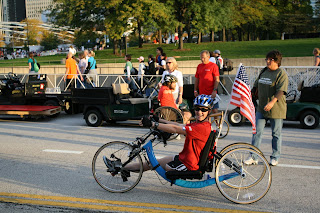Reprinted from The News-Gazette
September 21, 2008
©2008 The News-Gazette, Inc. All Rights Reserved
Erica’s race
Bounce in her step
UI student thrilled to be active again after recovery from illness, amputations
By JODI HECKEL
jheckel@news-gazette.com
URBANA — Erica Van Zuidam loves the feeling of a good workout that gets her heart pumping.
“It feels like how it used to be. My old life, in sports and everything,” she said. “I think that’s why it’s so fun. It brings back good times.”
On Saturday, Van Zuidam ran a 5-kilometer race — 3.1 miles in two laps around the University of Illinois campus, from the Illini Union to the Stock Pavilion. It was her first race on her carbon fiber legs with the zebra-striped cloth covering the top. Her first race since her feet and hands were amputated, the casualties of a nearly fatal case of bacterial meningitis she contracted at the end of her freshman year at the UI.
She believes she survived the disease because she was active and physically fit.
Saturday’s race was organized by the Kinesiology Student Association and held in honor of Van Zuidam, now a senior in kinesiology. It wasn’t just a chance for her to run and to promote an active lifestyle. It was also a chance to spread the word about bacterial meningitis and the vaccine that can protect against it. Included in the packet for runners was information about the disease.
Van Zuidam played volleyball in high school — her main sport — and she also ran the 800 during track season to keep in shape. She continued to be active at the UI, working out often for fun and to relieve stress.

But she contracted bacterial meningitis in May 2005, at the end of her freshman year. She was hospitalized for several months, then began therapy to learn to use prosthetic hands and to walk on prosthetic legs.
Through it all, she couldn’t wait to be active again. Even while learning to use her new legs, she knew she wanted running legs.
“I’m stubborn and I don’t like being told I can’t do something,” she said. “Even if I don’t run regularly, I don’t want to be told I don’t have the option.
“When I got my (regular prosthetic) legs, it was like, ‘All right, I want to move fast.’ That’s just who I am. I like to be going.”
She tried to run a few times with her regular prosthetics, but they aren’t made for running. She got the carbon fiber running legs in May 2007. Running in them was a rush.
Holy cow, my hair is moving fast again, she thought.
“I can’t really stand still when I’m in them. They’re really bouncy,” she said.
Even so, it took a lot of effort to run again. It’s particularly difficult in hot weather, because of how the prosthetics and liners fit her, so she often opts for swimming instead.
Mary Carlton, a UI professor of kinesiology and advisor for the Kinesiology Student Association, has come to know Van Zuidam well after teaching her in several classes.
“Erica has always been concerned about getting the word out about meningitis, and the idea that this is a disease you don’t have to get,” Carlton said. “This is one way to get Erica’s story out here, and she is one of our own and she’s a great kid.”
Van Zuidam acknowledged being nervous before the race. While she has long run to stay in shape, she’d never raced a 5K before.
She was cheered on by her parents, Tim and Janice. Younger sister Jamie, her boyfriend, and Dave Rotter, who works with Van Zuidam to fit her with her prostheses, all ran the race as well.

She ran better than she expected, completing the first mile without needing a break. She stopped twice during the race and removed her prosthetic legs, once to adjust the liners and another time for Jamie and a friend to massage a cramp out of her leg.
“She’s a fighter,” Rotter said of Van Zuidam. “She’s tough. She has a strong constitution.
“The key is not to have the mind-set of limitation, but of possibility.”
Van Zuidam said of Rotter: “He pretty much thinks I can do anything.”
PHOTO CAPTIONS ABOVE:
Robert K. O’Daniell photos/The News-Gazette
Erica Van Zuidam starts running a 5K race put on by the Kinesiology Student Association on Saturday on the UI campus in Urbana. ALSO: Van Zuidam wore the No. 1 for the race, held in her honor.
 We have a new series of posters that we are excited to share in this space. Soon, the ones you see here--as well as a few others--will be making their debuts in our offices in Chicago and throughout the region.
We have a new series of posters that we are excited to share in this space. Soon, the ones you see here--as well as a few others--will be making their debuts in our offices in Chicago and throughout the region. 




+and+Eric+Neufeld.jpg)

































